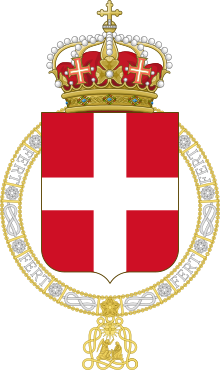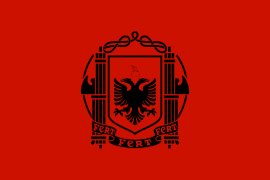| This article possibly contains original research. Please improve it by verifying the claims made and adding inline citations. Statements consisting only of original research should be removed. (August 2024) (Learn how and when to remove this message) |

FERT (sometimes tripled, FERT, FERT, FERT) is the motto of the royal House of Savoy and Kingdom of Italy. The motto was adopted by Duke Vittorio Amedeo II (1666–1732).
It appeared for the first time on the collar of the Supreme Order of the Most Holy Annunciation, or Ordine Supremo della Santissima Annunziata, the primary dynastic order of the kingdom. This ceased to be a national order when Italy became a republic in 1946. The order remains under the jurisdiction of the head of the House of Savoy, however, as hereditary Sovereign and Grand Master.
The meaning of the letters has been a matter of some controversy, to which a number of interpretations have been offered. The motto is believed to be an acronym of:
- Foedere et Religione Tenemur (Latin: "Treaty and religion bind us");
- Fortitudo Eius Rhodum Tenuit (Latin: "His strength conquered Rhodes" or "By his bravery he held Rhodes"), referring to the victory of Amadeus V, Count of Savoy (1249–1323), who fought in the 1315 siege of Rhodes; or either
- Fortitudo Eius Rempublicam Tenet (Latin: "His bravery preserves the state"); or
- Fides Est Regni Tutela (Latin: "Faith is the protector of Kingdom").
It has also been suggested that the letters are actually the Latin word fert (third-person singular present active indicative of ferre), meaning " suffers/bears", possibly referring to Jesus bearing the sins of the world. A French-language parody of FERT was said by Savoy's neighbors to mean Frappez, Entrez, Rompez Tout (French: "Strike, Enter, Break Everything"), from their penchant for chevauchée.
Gallery
-
 Stained glass with the coat of Amadeus VIII, Duke of Savoy
Stained glass with the coat of Amadeus VIII, Duke of Savoy
-
The motto in the main hall of the Palace of the Grand Master of the Knights of Rhodes
-
 Flag of the Italian Protectorate of Albania
Flag of the Italian Protectorate of Albania
See also
- A.E.I.O.U. – another motto of a European dynasty (the House of Habsburg) whose precise meaning and origin is unclear
References
- Melion, Walter; Zell, Michael; Woodall, Joanna (2017-11-09). Ut pictura amor: The Reflexive Imagery of Love in Artistic Theory and Practice, 1500-1700. BRILL. p. 428. ISBN 9789004346468.
- ^ Historic Devices, Badges, and War-cries by Mrs. Bury Palliser. S. Low, Son & Marston. 1870. p. 230.
- Sussex.), John Wilkes (of Milland House (1812). Encyclopaedia Londinensis; or an universal dictionary of arts, sciences, and literature ... publisher not identified. p. 811.
- Ulwencreutz, Lars (November 2013). Ulwencreutz's The Royal Families in Europe V. Lulu.com. p. 293. ISBN 9781304581358.